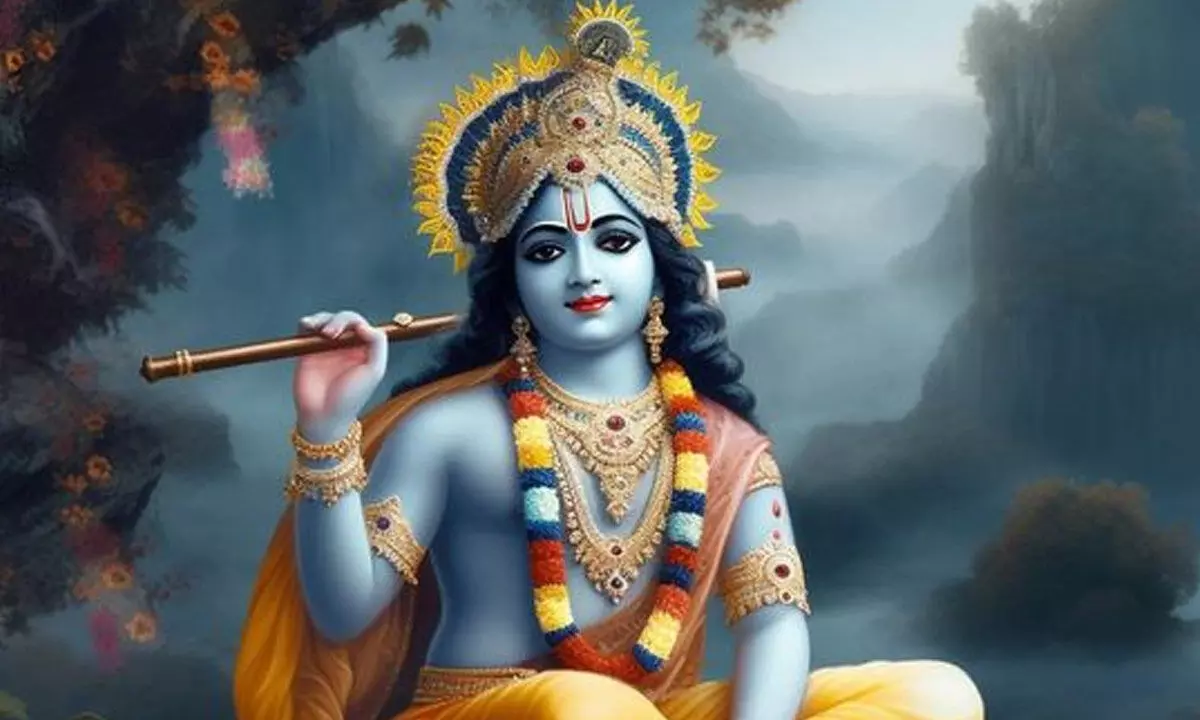Live
- They always want me to win, and now I feel lucky to have been offered a story like ‘Zebra’: Satyadev Kancharana
- ‘Democracy first, humanity first’: PM Modi in Guyana's parliament on two countries' similarities
- PKL Season 11: Telugu Titans register third straight win to top standings
- Is Pollution Contributing to Your COPD?
- NASA Unveils Underwater Robots for Exploring Jupiter's Moons
- Additional Central forces arrive in violence-hit Manipur
- AR Rahman and Saira Banu’s Divorce: Legal Insights into Common Issues in Bollywood Marriages
- 82.7 pc work completed in HPCL Rajasthan Refinery area: official
- Curfew relaxation extended in 5 Manipur districts on Friday
- Tab scam prompts Bengal govt to adopt caution over fund disbursement
Just In

Let us again look into the Gita to see an analysis made by Krishna about our vision of life, our values and our actions.
Let us again look into the Gita to see an analysis made by Krishna about our vision of life, our values and our actions. Arjuna’s mind was confused about his duty. Krishna’s purpose was to clarify the doubts in Arjuna’s mind from a larger perspective. In this context (Gita 18-18 to22) he talks about the vision of life of a person and how it determines his actions.
Our vision of life is formed by what we call samskaras. This is a technical word referring to the subconscious impressions of innumerable experiences in life which have crystallized over a period and have the tendency to influence our future actions. Our pleasant or unpleasant interaction teaches a lesson which remains as an impression, a samskara. We also believe in past lives, and hence past samskaras too, add up to these. In addition, our learning, whether in worldly sciences or on the spiritual path, also develops our vision. A person’s goal in life may be to make money, while someone else’s goal may be seeing different parts of the world, and someone else may like to acquire knowledge.
Krishna quotes the great sage Kapila, who first gave us the analysis of human nature in the framework of the three gunas. His school is known as the Sankhya school. As a predecessor of Krishna, he was probably among the first psychologists in the world. Krishna takes from him and says how our vision depends on the predominant guna in us.
A person of sattva guna develops a philosophical vision, a vision which sees things in a larger perspective. He tends to see oneness in all beings, human and non-human. He sees the presence of the imperishable, unchanging divine in all (18-20). The Divine is like the space, encompassing all, pervading all, in and out. What we call Brahman is like the reflection of sun falling on innumerable water bodies and appearing as different in all the bodies. The Brahman consciousness is what reflects in all the minds and senses of all beings and activates them. With such a vision a person sees all beings as his own self, loves them as he loves himself, unconditionally. The expression, ‘unity in diversity’ comes from this passage. This is the vision which liberates a person from the cycle of birth and death, the commentators say. This is the vision which leads to inner harmony in a person, which leads to social harmony, and which reduces conflicts in the world.
There is another vision inspired by rajo-guna. Here the person sees diversity. There are also philosophical schools in India which support this vision. For them, all beings are different, all are different from Brahman. People guided by this vision are numerous. Some religious actions fall under this category. They promise heaven or some other benefit and can also lead to purity of mind which may, in course of time, lead to sattva, and become liberating in nature.
Sometimes the vision of rajo-guna tends to make divisions among people. One good example is the divide and rule policy which the colonial rulers adopted in India. The seeds of division sown by them are giving their poisonous fruits even now.
The dangerous vision is that which is inspired by tamo-guna. In other parts of the Gita (17-19) Krishna describes the foolhardy nature and obstinate determination caused by this. A person inspired by this does not have an open mind or a thinking mind. He is blindly led by others. He may follow religious austerities which are dangerous to himself and to others. Such a vision leads to a demonical nature, unrest in one’s inner being, and also leads to social unrest.
Commenting on this verse, Vivekananda says, ‘no austerity should be undertaken for injuring other beings. It is the very negation of all spiritual ideals’ (vivekavani.com). The message for the seeker is that he should constantly try to develop the sattva tendencies.
(The writer is a former
DGP, Andhra Pradesh)

© 2024 Hyderabad Media House Limited/The Hans India. All rights reserved. Powered by hocalwire.com







